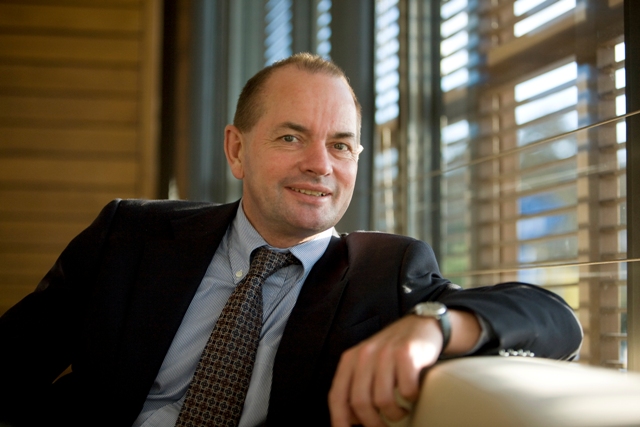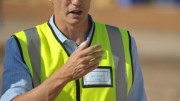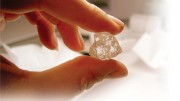Lukas Lundin is bullish on diamonds. The famed mining mogul and chairman of Lucara Diamond (TSX: LUC) sees rising demand and a lack of new discoveries as underpinning the healthy — although volatile — sector.
But the man behind the Lundin Group of Companies freely admits he’s no diamond expert.
“It’s a very complicated business,” Lundin said in a telephone interview from Geneva in late September.
“It’s very hard to find, it’s hard to produce, it’s hard to sell — there’s 3,000 different types — so you definitely need to be surrounded by people who know the business,” he continued. “Once you surround yourself with it, it’s a fascinating business, but it’s hard to get all the knowledge yourself.”
Known more for his investments in oil, base metals and gold, Lucara was Lundin’s first foray into diamonds. But he certainly ventured into the diamond business with the right guides.
Lundin started Lucara Diamond — which is enjoying enormous success at its rich Karowe mine in Botswana — with diamond sector bona fides Eira Thomas (Aber Resources, Stornoway Diamond [TSX: SWY], and current CEO of Kaminak Gold [TSXV: KAM]) and William Lamb (De Beers), as well as Catherine McLeod-Seltzer (Arequipa Resources, Stornoway Diamond and Bear Creek Mining [TSXV: BCM]).
“I wouldn’t have got the property without the people, because they had the right contacts.” Lundin says, adding he never would have known about the feasibility-stage project either.
Then known as the AK-6 project, Karowe was owned by De Beers and AIM-listed junior African Diamonds.
Lucara bought an initial 70% stake in the project in 2009 for US$49 million, acquired African Diamonds in an all-stock transaction in late 2010, and started construction around the same time.
Karowe achieved full production in mid-2012, with the first-phase cost coming in under Lucara’s budget of US$120 million.
Karowe, which is expected to produce 400,000 carats per year over a 13-year mine life, would be a profitable mine if it had performed as expected.
But the open-pit mine has consistently produced large, high-value diamonds that have Karowe generating so much cash that this year, Lucara became the first Lundin Group company to start paying out dividends — a move intended to appeal to yield-play investors and boost the share price.
“Whoever thought that (Lucara would be the first) — the most speculative thing I’ve ever done!” Lundin says, then adding: “Or maybe not.”
Lundin is the son of another famous resource sector entrepreneur, the late Adolf Lundin, who made his name and fortune making high-stakes acquisitions in oil and mining — including the Tenke Fungurume copper project in the Democratic Republic of the Congo. As such, his tolerance for risk is definitely on the high side. At presstime, Lundin company Fortress Minerals (soon to be renamed Lundin Gold) announced it’s buying the huge Fruta del Norte deposit in Ecuador — the country that instituted a 70% windfall profits tax in 2013 — from Kinross Gold (TSX: K; NYSE: KGC) for US$240 million.
Aside from political risk, Lundin is also willing to take on exploration risk. In Canada’s still young diamond sector, that means the risk of pouring money into expensive Arctic exploration programs and coming up empty-handed.
“Today the general public is not that keen on diamond exploration because it’s so hard. You find a pipe, you see if it’s diamondiferous, then you have to see if it’s economic, then you need a bulk sample — it just takes so long,” he says. “They had early success in the Northwest Territories, but it’s just so hard to get to the end game and you need so much patience and so much money.”
While Canadian diamond explorers have struggled to raise money since the Great Recession, when “the well ran dry,” Lundin has taken a chance with diamond junior North Arrow Minerals (TSXV: NAR).
Last year, Lundin took a nearly 20% stake in the company, chaired by former Aber Resources executive Grenville Thomas.
Aber, which has now become Dominion Diamond (TSX: DDC), discovered the Diavik mine with Rio Tinto (NYSE: RIO). With North Arrow, Lundin is again relying on the diamond expertise of people he knows and trusts.
“Gren Thomas and Eira said, ‘You know we have these properties that look quite interesting. They’ve been explored and they got to the 90-metre line and they couldn’t finish the program,’” Lundin recalls. “So I said, let’s pick up the best properties around and let’s finish off the drilling or the sampling we have to do, because there’s been so much money and time spent on it already, you’re at the end game.”
The result is that North Arrow was able to raise $3 million to get started in March 2013. Since then, it’s raised another $10 million and amassed a portfolio of seven prospective diamond projects that have seen much of the early, expensive work already done — removing a lot of technical risk.
“I’m not sure if they’re going to be good or bad,” Lundin says. “But there’s been so much work, it’s worth trying it.”
Several of the projects — including Qilalugaq, the most advanced — were generated by Stornoway, which is now focused on building its Renard mine in Quebec.
The potential of North Arrow’s most advanced project, Qilalugaq, will soon be clearer. After taking a bulk sample from the Q1-4 kimberlite this summer, the company’s expecting a diamond valuation in the first quarter of 2015 that will help it assess the project.
Karowe
Lundin is of the school of thought that sees diamonds as an indulgence (a big theme of De Beers recent Insight Report, see Page 4), rather than a commodity.
“Diamonds are very unique; I look at them more as a luxury good — it’s like a Picasso painting or something.”
It’s not hard to see why, when you factor in the extraordinary diamonds that Karowe has been producing.
To the end of September, Lucara has mined 1,400 diamonds larger than 10.8 carats and nine larger than 200 carats — including “exceptional” stones that Lucara sells in special tenders.
Fifty exceptional stones sold this year have generated revenues of $135.6 million at an average value of $32,468 per carat. That’s over half of Lucara’s 2014 forecasted revenue of US$240-250 million. (The special diamonds led the company to revise its forecast upwards from US$150-160 million at the beginning of the year.)
“We have so many unique diamonds,” Lundin says. “Twenty-five per cent of our diamonds are Type IIA, which means less nitrogen in them and only 0.2% of the world’s diamonds have that so they’re actually quite unique in large diamonds.”
Large diamonds boosted the mine’s average diamond price to US$764 per carat in the first half of the year, vs. a late 2011 valuation of Karowe diamonds that came up with a value at US$301 per carat.
“We didn’t expect to recover as many big diamonds as we have,” says Lundin, who adds it has helped that the company uses autogenous grinding at its processing plant, rather than semi-autogenous grinding, which is more conventional in Botswana and South Africa.
“It’s more careful with the rock,” Lundin says, and less likely to break diamonds.
As Lucara prepares to mine the fresher, harder kimberlite encountered in the AK-6 kimberlite’s south lobe, which is also the biggest of the north, central and south lobes, the company is spending US$55 million on a plant upgrade this year. A large diamond recovery circuit, which will allow the company to recover diamonds up to 60-70 mm, will also be installed.
The upgraded plant will be ready for commissioning at the end of the first quarter of 2015.
So what’s next for Lucara?
With all the cash flow Karowe is generating, another acquisition is likely — but only when the time is right.
“If I can get another six months to get the plant upgraded and then get the true value, then we’ll see what to do,” Lundin says.
Lucara has no debt and at the end of June, had US$82.1 million in cash.
In the meantime, the company is preparing to do some near-mine site exploration: in September, it picked up two concessions with kimberlite pipes that lie within a 30-km radius of Karowe.
“De Beers did a lot of work on them and they found some microdiamonds in them, but then they left them, so we picked up two of them,” Lundin says.
Lucara has already acquired a bulk-sample plant for $2.5 million to test the kimberlites, which were discovered in the late 1960s.
“I think there’s more to be done in that area because De Beers found Jwaneng and all those big mines there and then they didn’t do anything else. They didn’t have to,” Lundin said, alluding to the richness of Botswana’s diamond mines.
The nearby Orapa mine, owned by Debswana (a 50/50 joint venture of De Beers), is the richest diamond mine in the world, producing 12.9 million carats a year.
Investors can also expect an announcement with regards to Lucara’s Mothae project, in Lesotho, before the end of the year. Lundin says the project needs a little more testing, but the company is looking at a small-scale, 1-million-tonne-per-year plant to start out with.
Lucara Diamond shares traded at $2.22 in late October, in a 52-week range of $1.22-2.88. The company has 379 million shares outstanding, and the Lundin family, through two family trusts and Lukas Lundin’s owns holdings, own 18.9% of Lucara’s outstanding shares.




Be the first to comment on "Lukas Lundin talks diamonds"